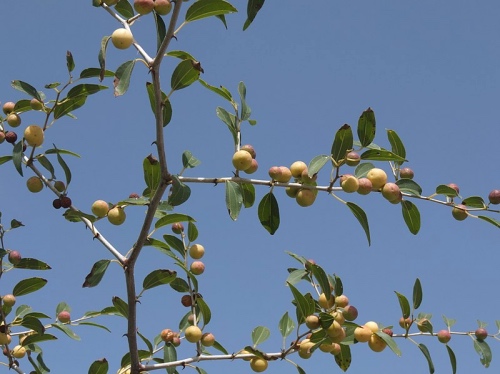
ALVIN JOHNSON looks at what the plant known as the ‘atad’ or thornbush mentioned in the Old Testament Book of Judges actually is…
The atad is mentioned in Jotham’s parable which is found in Judges 9:7–15.
The context of the parable takes place after Jotham’s brothers had all been killed by his half-brother Abimelech. Both Abimelech and Jotham were sons of the judge, Gideon. Abimelech was, with the aid of its inhabitants, made king in Shechem. Jotham then climbed Mount Gerizim above the city of Shechem and ‘shouted‘:

Christ’s Thorn – the most likely candidate for the Atad. PICTURE: Davidbena/licensed under CC BY-SA 4.0.
“Listen to me, citizens of Shechem, so that God may listen to you. One day the trees went out to anoint a king for themselves. They said to the olive tree, ‘Be our king.’
But the olive tree answered, ‘Should I give up my oil, by which both gods and men are honoured, to hold sway over the trees?’
Next, the trees said to the fig tree, ‘Come and be our king.’
But the fig tree replied, ‘Should I give up my fruit, so good and sweet, to hold sway over the trees?’
Then the trees said to the vine, ‘Come and be our king.’
But the vine answered, ‘Should I give up my wine, which cheers both gods and men, to hold sway over the trees?’
Finally all the trees said to the atad (thornbush), ‘Come and be our king.’
The atad (thornbush) said to the trees, ‘If you really want to anoint me king over you, come and take refuge in my shade; but if not, then let fire come out of the atad (thornbush) and consume the cedars of Lebanon!’”
The atad is here translated as ‘thornbush’ and there are two main possibilities for what the atad might be. They are:
• The jujube (also called Christ’s thorn) – Ziziphus spina-christi (sometimes called Rhamnus spina christi); and,
• The boxthorn (also called the European teatree) – Lycium europaeum.
The jujube is an evergreen tree with thick foliage which gives shade even when it is leafless. It produces edible fruits and has quite sharp thorns – for this reason it is thought to be the tree from which Jesus’ crown of thorns was made (although there is another plant which might be a more likely prospect for this). The jujube is found in valleys up to an elevation of 500 metres.
In the reference by Jotham to fire coming out of the atad, Nogah Hareuveni, in Tree and Shrub in Our Biblical Heritage, says of the jujube, “Both, the thin and thicker branches quickly catch fire and burn brightly, generating much heat with very little smoke”.
Apart from references to the “threshing floor of Atad” (Genesis 50:10-11), the atad, as a plant, is only mentioned in one other Old Testament verse. This is found in Psalm 58:9 where it was used as a tree for firewood in the home: “Before your pots can feel the heat of the atad (thorns) – whether they be green or dry – the wicked will be swept away.”
The atad is also identified as a species from the Lycium genus. The specific species is the boxthorn or European teatree (Lycium europaeum). This is a shrub-size plant which also has sharp thorns. The comment about taking “refuge in my shade” would be ironical if the atad is the boxthorn, because, according to Hareuveni “the trunk is not readily visible. Whether because of its growth patterns, many branches seem to grow up from the ground, with a single central trunk. Because of this the yikshat (boxthorn) has no shade…”
Hareuveni rejects the identification of the atad with the European teatree because it does not easily catch fire. Even when dry and deliberately set alight the fire does not spread to other branches very easily. So this fact regarding the boxthorn does not fit Jotham’s comment regarding the fire coming out from the atad.
There is also the suggestion that the atad is buckthorn from the Rhamnus genus. This genus includes species such as the Rhamnus alaternus (Italian or common buckthorn) , Rhamnus lotus or Ziziphus lotus (lotus jujube) which grows to about two metres in height, or Rhamnus lycioides (Mediterranean buckthorn).
This is an edited excerpt from Alvin Johnson’s iBook ‘Biblical Flora’, 2017. The book is available for free download on iTunes. A teacher’s edition is also available for purchase.






